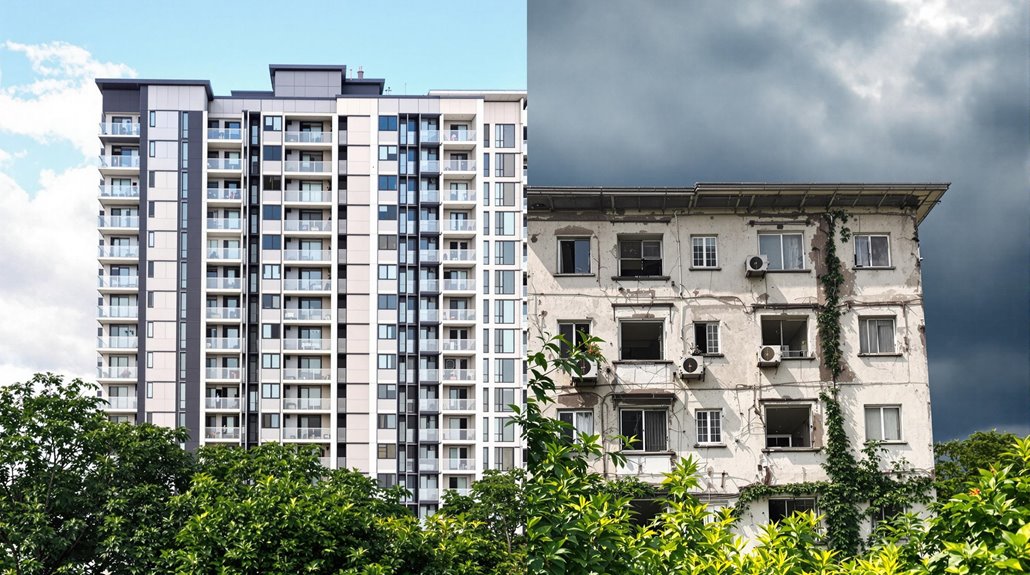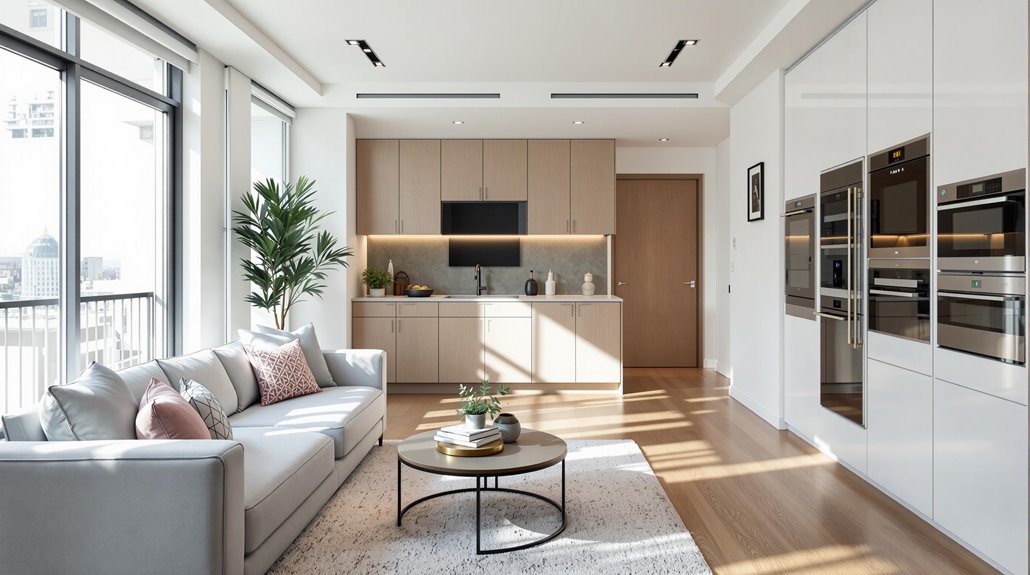Condo dwelling coverage protects interior structural elements within unit boundaries, including permanent fixtures, cabinets, flooring, and built-ins. Coverage requirements vary based on the master policy type, with options ranging from bare walls to all-in coverage. Determining adequate coverage involves analyzing local construction costs, unit improvements, and building characteristics. Professional assessments help identify potential gaps between master policy limits and unit-specific needs. Understanding these nuances becomes critical for complete protection.
Key Takeaways
- Dwelling coverage protects structural elements within your condo unit, including fixtures, cabinets, flooring, and built-in improvements.
- Coverage needs depend on your HOA's master policy type: all-in, single entity, or bare walls coverage.
- Get professional assessment from insurance agents to determine accurate replacement costs based on local construction prices.
- Review and document unit improvements annually, as these modifications affect needed coverage amounts.
- Calculate coverage based on current construction costs, unit location, building age, and compliance requirements.
Understanding Your Condo's Master Policy
When purchasing a condominium, understanding the master insurance policy is essential for determining appropriate dwelling coverage and identifying potential coverage gaps. The master policy, also known as condominium association insurance, provides coverage for the building’s physical structure, common areas, and shared elements. It is vital for buyers to review the specifics of the master insurance policy, as it dictates what is covered and what falls under the homeowner’s individual responsibility. Additionally, understanding the limits and exclusions of the condo association insurance policy explained is crucial, as this knowledge can help you make informed decisions about your personal insurance needs. By being aware of the coverage details, you can better safeguard your investment and avoid any unexpected financial burdens in the future.
This foundational coverage encompasses exterior components such as walls, roofing, and foundation, along with internal common elements including hallways, elevators, and shared mechanical systems.
Policy limits are established based on the total replacement value of these covered structures and areas. Assessment requirements may impact unit owners when damages exceed coverage limits or when per-unit deductibles apply.
The master policy typically excludes interior unit fixtures, personal property, and individual unit upgrades, creating a need for supplemental coverage. Unit owners must carefully review the master policy's scope to guarantee complete protection through additional personal condominium insurance that addresses these exclusions. Loss assessment coverage can help protect unit owners from their share of special assessments charged by the condo association for covered losses.
The Basics of Dwelling Coverage for Condos

As condo owners navigate their insurance needs, understanding dwelling coverage becomes paramount for protecting their financial investment within their unit.
This specialized form of interior protection differs substantially from traditional homeowners insurance, focusing specifically on structural elements within the unit's boundaries rather than the entire building.
The dwelling basics of condo coverage encompass essential structural components and built-in features, including:
- Permanent fixtures such as cabinets, flooring, and built-in appliances
- Interior walls, ceilings, and structural improvements
- Unit-specific upgrades or modifications made by the owner
The extent of necessary coverage largely depends on the type of master policy maintained by the condo association. While "all-in" policies provide broader protection, "bare walls-in" policies require unit owners to secure more thorough dwelling coverage. Regular assessment of coverage needs guarant
When filing claims, working with public adjusters can help condo owners better understand their coverage options and maximize their insurance benefits.
Calculating the Right Amount of Coverage

Determining accurate dwelling coverage requires a careful analysis of local construction costs, which can vary substantially by region and market conditions.
A professional assessment from a qualified insurance agent or appraiser provides critical insight into specific coverage needs based on the unit's location, upgrades, and unique characteristics.
Special considerations must be given to custom features, high-end finishes, and structural improvements that exceed standard building specifications, as these elements can substantially impact the required coverage amount.
Regular maintenance and documenting pre-existing conditions can help secure lower insurance premiums while ensuring adequate protection for your investment.
Using Local Building Costs
Local building costs fundamentally drive the calculation of appropriate dwelling coverage for condominium units.
Regional prices and builder fees vary substantially based on location, materials, and construction techniques. Understanding these local variations is essential for determining adequate insurance coverage that reflects true replacement costs.
Key factors affecting local building costs include:
- Building age and construction type, which influence compliance with current building codes
- Geographic location and exposure to natural disasters
- Material quality and availability in the region
Insurance providers consider these elements when evaluating dwelling coverage requirements.
Buildings constructed with modern materials may qualify for lower rates, while older structures often require higher coverage due to increased replacement costs and potential code upgrades. Regular assessment of local construction costs guarantees coverage remains aligned with current market conditions.
Working with public adjusters can help accurately assess replacement costs for complex claims involving extensive structural damage.
Get Professional Assessment First
Before establishing appropriate dwelling coverage for a condominium unit, owners should obtain a professional assessment to accurately determine their insurance needs. Professional insights from experienced insurance agents can help evaluate replacement cost values and identify coverage gaps between the association's master policy and individual unit requirements.
Assessment methods typically include reviewing the master policy to determine if it's "all in" or "bare walls in," calculating coverage based on square footage and local reconstruction costs, and considering lender requirements.
Insurance agents can provide detailed analyses of coverage needs while factoring in current construction costs and property values. This systematic approach helps prevent underinsurance risks and guarantees compliance with mortgage lender requirements while providing appropriate protection for the unit owner's investment. Understanding standard policy exclusions is crucial when determining appropriate dwelling coverage levels to avoid gaps in protection.
Factor Special Upgrades In
A condo unit's special upgrades and custom improvements require careful consideration when calculating appropriate dwelling coverage.
When owners enhance their units with customized finishes and luxury installations, these modifications often exceed the coverage provided by standard HOA master policies, potentially creating significant financial exposure.
Working with independent insurance agents can help identify potential savings while ensuring comprehensive coverage for upgraded elements.
To guarantee adequate protection for upgraded elements, owners should:
- Document all improvements with detailed receipts, photographs, and professional appraisals
- Calculate the current replacement cost of high-end materials and custom installations
- Review and adjust dwelling coverage annually to reflect both market conditions and new upgrades
Proper documentation and regular assessment of these improvements enable accurate coverage calculations, protecting the owner's investment in premium features such as custom cabinetry, designer fixtures, and specialized building materials.
Key Factors That Impact Your Coverage Needs

Understanding the key factors that impact condo dwelling coverage is essential for determining appropriate insurance protection levels. The type of master policy in place substantially influences coverage requirements, with all-in policies requiring less individual coverage compared to bare-walls-in policies that mandate thorough interior protection.
Environmental impact plays a vital role, as geographical location and proximity to natural disaster zones directly affect premium costs and coverage duration requirements. Properties in hurricane-prone areas or regions with frequent severe weather typically necessitate more robust coverage.
Additionally, the building's age and condition serve as critical determinants, with older structures or those with outdated systems requiring higher coverage levels. Individual unit considerations, including improvements, built-in appliances, and unique features, must also be evaluated when determining adequate coverage. Regular assessment of these factors guarantees that dwelling coverage remains aligned with current risks and property values. Since only 27% of homeowners in flood-prone areas carry flood insurance, it's crucial to verify whether supplemental coverage is needed for natural disasters.
Common Coverage Gaps to Watch For

While evaluating coverage needs based on key factors provides a foundation for protection, identifying potential coverage gaps requires careful attention to prevent costly oversights.
Common coverage shortfalls often emerge from misaligned master policy deductibles and unit owner coverage limits, creating insurance mismatches that expose owners to significant financial risk.
Several critical areas demand vigilant monitoring to prevent coverage gaps:
- Rising master policy deductibles, which can reach $500,000, may exceed unit owners' loss assessment coverage
- Understated dwelling coverage limits that fail to account for actual reconstruction costs, upgrades, and improvements
- Inadequate property damage coverage due to measurement errors or misunderstood policy terms
Regular policy reviews are essential to identify and address these gaps, particularly as construction costs fluctuate and property values change.
Unit owners must guarantee their individual policies align with master policy requirements and provide sufficient protection for their specific circumstances.
Working with public adjusters can help condo owners secure 30-50% higher settlements when coverage gaps lead to claim disputes.
Types of Condo Insurance Policies Explained

Condo insurance policies come in three distinct master policy types, each offering varying levels of protection and requiring different supplemental coverage from unit owners.
All-in coverage provides the most thorough Master Coverage, protecting built-in elements, fixtures, and improvements within units. Under this policy, owners typically require minimal supplemental dwelling coverage.
Single entity coverage insures original fixtures and appliances but excludes owner improvements, necessitating additional coverage for upgrades.
Policy Comparisons reveal that bare walls coverage offers the most limited protection, covering only basic structural elements like walls, floors, and ceilings. This type requires unit owners to secure substantial dwelling coverage for interior features, fixtures, and appliances.
Understanding these distinctions is vital for determining appropriate supplemental coverage needs. Unit owners must carefully review their association's master policy type to identify coverage gaps and guarantee adequate protection for their investment.
While not legally mandated, mortgage-free condos still benefit significantly from maintaining comprehensive insurance coverage.
Essential Tips for Protecting Your Investment

Protecting a condominium investment requires careful assessment of coverage needs based on both market value and replacement costs.
Regular policy updates guarantee coverage adapts to changing property values, renovation improvements, and evolving risk factors.
Strategic protection through complete dwelling coverage maximizes financial safeguards against property damage, liability claims, and potential loss scenarios.
Understanding your insurance declaration page helps prevent coverage gaps while ensuring proper limits and deductibles for your condo policy.
Assess Your Coverage Needs
Understanding how much dwelling coverage to purchase represents a critical first step in safeguarding a condominium investment.
A thorough coverage assessment begins with reviewing the HOA master policy to identify existing protections and coverage gaps.
Insurance evaluation methods typically include analyzing local construction costs and calculating potential rebuilding expenses.
Working with insurance professionals to bundle multiple policies can result in premium savings of 15-25% while maintaining comprehensive protection.
Key elements for determining appropriate coverage levels include:
- Evaluating the HOA master policy type (bare walls, single entity, or all-in) to understand baseline coverage
- Calculating dwelling coverage using either the 20% method or square footage approach based on local construction costs
- Factoring in improvements, upgrades, and mortgage lender requirements when determining final coverage amounts
These assessments help guarantee adequate protection against potential losses while avoiding unnecessary overlap with existing HOA coverage.
Regular Policy Updates Matter
Regular insurance policy updates serve as a critical safeguard for condominium investments, requiring systematic review and adjustment to maintain ideal coverage levels. These updates guarantee alignment with current market trends, construction costs, and regulatory requirements established by entities like Fannie Mae and Freddie Mac.
Annual review intervals allow property owners to assess and modify coverage based on structural changes, renovations, or shifts in occupancy patterns. This systematic approach helps prevent both over-insurance and dangerous coverage gaps.
Insurance professionals recommend documenting all property modifications and monitoring local construction cost fluctuations to determine appropriate dwelling coverage adjustments. Additionally, regular assessments enable compliance with updated standards while accounting for external risk factors that may necessitate supplemental coverage options.
This proactive strategy ultimately safeguards the property's value and ensures sustained financial protection. With inflation rates consistently impacting construction and repair costs, maintaining appropriate coverage becomes even more essential for long-term security.
Maximize Protection Value
To maximize protection value in condominium insurance, owners must implement a thorough assessment strategy that addresses multiple coverage dimensions.
By conducting regular evaluations of coverage needs and potential gaps, owners can enhance their protection while optimizing insurance costs.
- Review master policy details to identify coverage gaps between HOA insurance and individual unit needs, especially focusing on interior finishes and structural components
- Calculate precise dwelling coverage requirements based on current construction costs, square footage, and unique unit features
- Assess liability exposure relative to net worth and lifestyle factors, considering enhanced protection through umbrella policies
These systematic assessments help guarantee complete coverage while avoiding both over-insurance and dangerous coverage shortfalls.
Regular monitoring of local construction costs and property values enables timely adjustments to maintain peak protection levels.
Consider working with public adjusters to potentially increase insurance claim settlements by 30-50% when losses occur.
Steps to Update Your Coverage Over Time

As condominium ownership evolves over time, maintaining appropriate dwelling coverage requires systematic monitoring and periodic adjustments.
Effective policy monitoring involves annual reviews of coverage limits, assessment of unit upgrades, and evaluation of changes in local construction costs.
The coverage timing process should include regular verification of HOA master policy modifications, which may affect individual unit coverage requirements.
Unit owners must maintain detailed records of improvements and renovations, adjusting dwelling coverage to reflect increased value.
Additionally, owners should guarantee their policy includes automatic inflation adjustments and meets current mortgage lender requirements.
Changes in ownership structure, market values, or substantial renovations necessitate immediate coverage updates.
Insurance professionals recommend consulting with an agent when significant changes occur to ensure coverage alignment with current circumstances.
This proactive approach helps prevent coverage gaps and maintains adequate protection for the investment.
Documenting all emergency measures taken during incidents like flooding or break-ins ensures proper claim processing and reimbursement.
The Benefits Of Consulting A Public Adjuster

Public adjusters provide specialized expertise in maneuvering complex insurance claims, offering objective property damage assessments that align with policy coverage terms.
Their professional involvement streamlines the claims process through systematic documentation, skilled negotiation, and thorough understanding of policy language.
Statistical evidence demonstrates that claims handled by public adjusters often result in substantially higher settlements, exemplified by cases where initial offers were increased by millions through proper representation and expert claim management.
Studies show that hurricane-related claims achieve 700% higher settlements when public adjusters represent policyholders during the process.
Expertise In Insurance Claims
Handling complex insurance claims requires specialized expertise that many condo owners lack when dealing with property damage or loss.
Public adjusters provide essential policy expertise and claims mastery through their thorough understanding of insurance procedures and regulations.
Their professional knowledge enables accurate interpretation of policy terms and maximizes potential settlements.
Key areas where public adjusters demonstrate their expertise include:
- Thorough analysis of insurance policies to identify all available coverage benefits
- Strategic negotiation with insurance companies to counteract claim reduction tactics
- Navigation of state-specific insurance regulations and compliance requirements
This specialized knowledge proves particularly valuable in complex condo claims, where multiple coverage types and shared property considerations often complicate the settlement process.
Their expertise helps guarantee policyholders receive fair compensation while maintaining compliance with relevant insurance regulations.
Objective Damage Assessment
Beyond mastering insurance policies and regulations, an objective assessment of property damage forms the foundation of successful condo claims. Public adjusters employ systematic damage verification processes to guarantee complete coverage of affected areas and items.
Their unbiased evaluations follow strict industry standards, documenting evidence through detailed reports, photographs, and video documentation.
Through methodical hazard identification, public adjusters distinguish between covered and non-covered damages, providing a clear basis for claims processing. Their professional expertise enables accurate assessment of structural issues, content damage, and associated risks.
This systematic approach helps prevent coverage gaps and ensures all legitimate damages are properly documented. The thorough documentation and evaluation process strengthens the claim's validity while facilitating fair settlements based on objective evidence rather than subjective interpretations.
Streamlined Claim Process
While handling complex insurance claims can overwhelm condo owners, consulting a public adjuster streamlines the entire process through professional expertise and systematic claims management.
These professionals enhance claim automation by meticulously documenting damages, interpreting policy details, and managing required paperwork with time efficiency.
Public adjusters protect policyholder interests through skilled negotiation and advocacy, often working on a contingency basis without upfront costs.
Their expertise typically results in optimized settlements and reduced stress during the claims process.
Key advantages of utilizing public adjusters include:
- Professional documentation and evidence collection that strengthens claim validity
- Expert policy interpretation ensuring maximum coverage benefits
- Strategic negotiation capabilities that counter insurance company tactics to minimize payouts
Higher Claim Payouts & Settlements
Public adjusters consistently secure higher claim payouts for condo owners through strategic advocacy and thorough damage assessment protocols.
By leveraging their expertise in policy interpretation and current settlement trends, these professionals meticulously document property damage and coordinate with specialists to build complete claims.
Working on a contingency basis incentivizes public adjusters to maximize compensation through effective negotiation techniques.
They conduct detailed property inspections, gather supporting evidence, and present well-documented evaluations to insurance carriers. Their understanding of industry standards enables them to guarantee all relevant costs are included in the claim assessment.
Through professional mediation and strategic communication, public adjusters help minimize disputes while advocating for fair settlements, ultimately reducing legal expenses and expediting the claims resolution process.
About The Public Claims Adjusters Network (PCAN)

The Public Claims Adjusters Network (PCAN) represents a coalition of licensed professionals who specialize in advocating for policyholders during insurance claims processes.
With strict adjuster certification requirements and extensive network partnerships, PCAN members provide thorough support services while maintaining the highest standards of professional conduct and expertise.
These professionals operate on a contingency fee basis, guaranteeing alignment with policyholder interests and eliminating upfront costs.
Their specialized knowledge of insurance policies and claims procedures enables them to effectively navigate complex settlement negotiations.
Key advantages of PCAN membership include:
- Access to a nationwide network of experienced adjusters with proven track records
- Standardized professional practices that guarantee consistent, high-quality service delivery
- Ongoing professional development and resource sharing among network members
PCAN's commitment to policyholder advocacy distinguishes its members from insurance company adjusters, who represent insurer interests.
This fundamental difference in representation guarantees focused attention on maximizing claim settlements while maintaining objectivity throughout the claims process.
Frequently Asked Questions
Does Dwelling Coverage Protect Against Damage Caused by Pets?
Standard dwelling coverage typically excludes behavioral damage caused by pets. Pet-related destruction to structures falls under common pet exclusions and requires separate consideration for risk management purposes.
Can I Share Dwelling Coverage With an Adjoining Unit Owner?
Dwelling coverage sharing between adjoining unit owners is not permitted due to liability allocation concerns, individual policy requirements, and insurance company restrictions governing separate property coverage responsibilities.
Will Dwelling Coverage Pay for Code Upgrades During Repairs?
Building code updates can increase repair costs by 25-50%. Standard dwelling coverage excludes building codes and upgrade requirements unless specifically endorsed through an Ordinance or Law coverage addition.
Does Dwelling Coverage Transfer Automatically When Selling My Condo?
Dwelling coverage does not include automatic ownership transfer during a condo sale. The seller's policy typically terminates upon closing, requiring new owners to secure their own independent coverage protection.
Are Temporary Repairs Covered While Waiting for Insurance Approval?
Studies show 89% of insurers cover emergency repairs while awaiting claim approval. Provisional measures must be documented, reasonable, and necessary to prevent further damage. Failure to implement temporary repairs risks denial of subsequent damages.
References
- https://www.nerdwallet.com/article/insurance/dwelling-coverage-homeowners
- https://www.fullerins.com/blog/dwelling-coverage-for-condo-insurance
- https://stantonins.com/how-much-condo-insurance-do-i-need/
- https://www.insurance.com/home-and-renters-insurance/condo-insurance/how-much-dwelling-coverage-do-i-need-for-condo
- https://www.insurance.com/home-and-renters-insurance/home-insurance-basics/condo-insurance-how-much-is-enough-.html
- https://www.lopriore.com/blog/guide-to-condo-master-insurance/
- https://homebuyer.com/learn/master-condo-policy
- https://selling-guide.fanniemae.com/sel/b7-3-03/master-property-insurance-requirements-project-developments
- https://www.lopriore.com/blog/how-much-dwelling-coverage-do-i-need-for-a-condo/
- https://www.valuepenguin.com/homeowners-insurance/how-much-dwelling-coverage-to-get-condo-insurance








